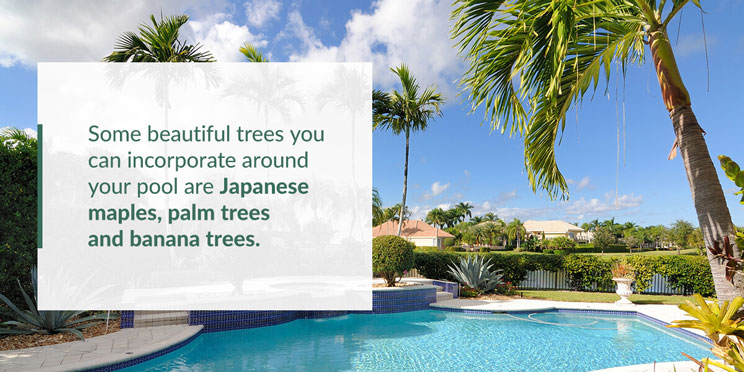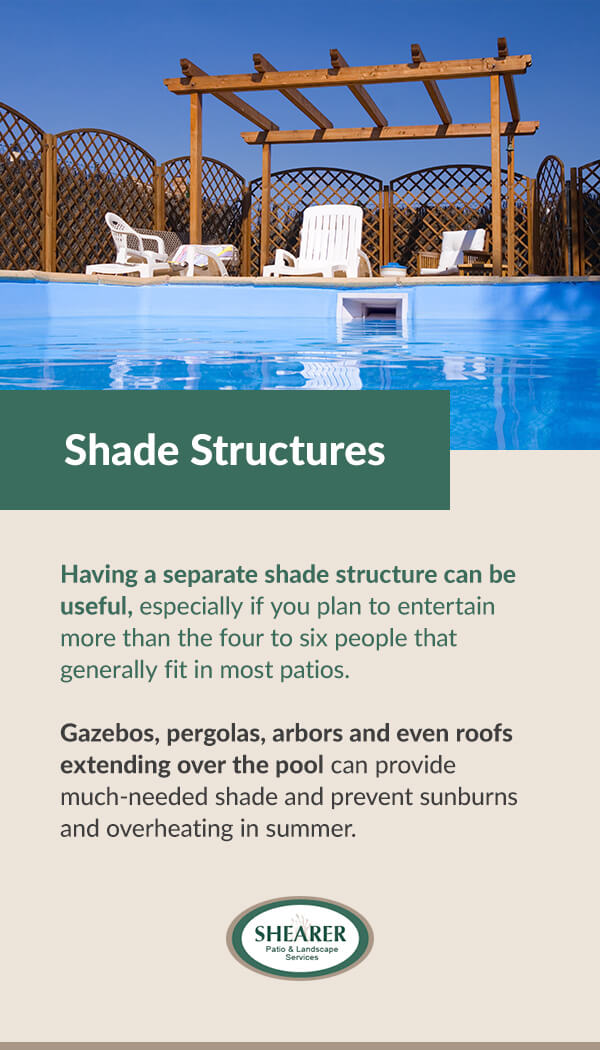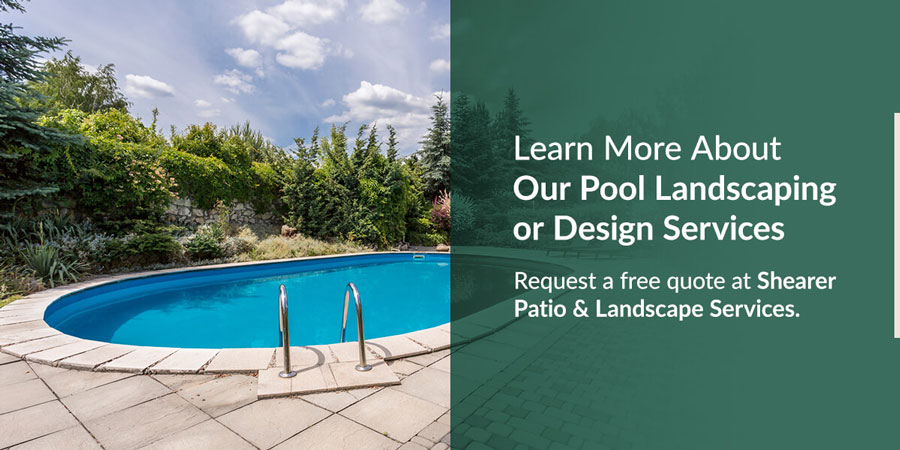
A pool will turn your backyard into an oasis. If you are thinking about an inground pool for your backyard, or maybe you already have one, you know having a pool requires upkeep but is undoubtedly worth the effort. Whether it’s your backyard pool or a community center, a pool can be at the heart of fun activities. You can enhance the experience for your swimmers and guests with excellent pool landscaping.
This guide will help you think about your goals for your pool and how the landscaping design fits into those goals. If you value privacy and simplicity, for example, you might take a different approach from someone who wants a pool that will make everyone stop and stare. You’ll also get a list of great ideas to consider, plus some pool landscaping to avoid. From big decisions like fencing, trees and lighting to smaller touches like decorations and finishing touches, this guide covers it all. Keep reading to find inspiration for your backyard oasis!
When thinking about inground pool landscaping ideas, you also want to consider these four essential factors related to your situation. Answering these questions can help you plan and decide which landscaping ideas are right for your inground pool.
There are so many great inground pool landscaping ideas that it can be hard to decide what is best for your situation. This breakdown will help you think about the different inground and above-ground pool landscaping ideas. No matter what your goals are, this guide can help you make the right choice for your inground pool landscaping.
Fencing can have three functions — aesthetics, privacy and safety. Your fencing selection depends on your needs in these three categories. For example, a family with young children who play in the yard may want a pool with a fence so the kids can enjoy themselves in the yard without risk.
If you live in a busy area with access to the street, a privacy fence can keep your yard private and secluded. Quality wood fencing will stand the test of time and provide you with the privacy and safety you need. Metal fencing is also an option if you don’t mind a little visibility from the street. Having both a fence around your pool and an outside fence can make your yard safe without sacrificing style.
If you want to install a fence but are worried it may interrupt the flow of your design, you can incorporate these barriers into your landscaping. If your only concern is privacy, you can use shrubbery or other vegetation to create a fence-like barrier. Or, if a fence is a must, you can soften the look with metal artwork or vining plants and flowers.
Keep in mind that some states have regulations about fencing around pools. The Consumer Product Safety Commission (CPSC) recommends pools be completely fenced in with self-closing and latched gates to help prevent drownings.
The lighting for your backyard pool landscaping can set the mood for relaxation and fun. Having improper lighting can be a safety concern for everyone, while proper lighting increases safety, aesthetics and value to the landscaping design of the pool. Lamps or built-in lights along the walkway can help people make their way through the backyard when the sun goes down. String lights strung around or near the pool can add a relaxing, ethereal glow to your space. If you want more overhead lighting options, you can even install lights in the trees around your yard.
A fire can set a cozy mood, and features like torches and fire pits can add warmth to cool nights and a non-electric way to illuminate your pool area. A fire pit can double as a source of heat and a source of fun — have a hot dog or marshmallow roast for entertainment that pleases all ages or sit around it as you tell scary campfire stories. You can also get citronella torches to repel mosquitos and other bugs.
When installing landscape and pool lighting, take safety precautions to ensure no water can interfere with the electrical circuit, and keep wires and outlets well away from the pool area. Motion detector lights can be helpful to light your way at night without wasting too much energy. Installing weather-resistant security lights on the outside of your fence can be an additional deterrent for potential thieves.
In addition to lighting and fencing, including plants in your pool landscape design can create a more natural look for your property. Large shrubs and evergreen bushes on the perimeter can act as natural fences, and flowering plants can add pops of color to your yard. Whatever plants you use, keep in mind that salt water and chlorine can harm some plants, so choose and place those accordingly.
The shrubs and flowers you plant depends on the climate of your region. If you would like to grow a plant that works best in a climate warmer than yours, you can sometimes use a planter and bring it inside in the winter. Some popular pool landscaping plants include:
Succulents are a fantastic choice for arid climates since they are drought resistant. Certain species can survive in other environments, but they may need to come inside during the cold winter months. Additionally, vining plants near the pool fence and trellises are great choices for decorating the perimeter of your yard.

Trees can add much-needed shade to escape the sun’s heat, which is essential when you spend time outdoors. Shade can also keep the ground and pool water from becoming too hot. Some beautiful trees you can incorporate around your pool are Japanese maples, palm trees and banana trees. Some of the worst trees to plant near a pool include sycamores because they tend to drop a lot of bark, seed pods and leaves. Fruit trees can also be a bad idea because they may attract bugs.
If you already have large trees on your property, a professional can trim them back to reduce the number of leaves and sticks in your pool. If your trees are close to the pool, consult a landscaper since tree roots can sometimes interfere with or damage your pool.
Hardiness and durability are two important factors for choosing grass since pool chemicals can be harmful, and the grass will have to stand up to a lot of wear and tear. Bermuda and zoysia grasses tend to hold up well to frequent use and can repair themselves easily.
For any shrubs, trees or other plants you include in your inground pool landscapes, check the hardiness zone to determine what grows best where you live.
Inground and above-ground swimming pool landscaping ideas must also include seating and gathering areas. Having a deck or patio around your inground pool can be convenient for relaxing in between swims and for entertaining. On your deck or patio, in addition to the typical table and chairs, consider including:
Having spaces for people to gather will make your pool an inviting place for entertaining and relaxing. Including cushions and bean bags made for outdoor use is a fun way to add more creative seating options, and umbrellas or other coverings can provide shelter from rain and sun. Plants can add bright pops of color and complement the designs of your cushions and other decorations.
Want to extend the use of your patio or deck into the winter? Consider enclosing it for added weather protection and including a fire pit or other heat source to keep people warm. Even though you may not be able to use your pool in the colder months, you can still enjoy the beautiful design of your landscaping all year round.
There are countless benefits to adding a deck or patio to your landscaping around your swimming pool. You can even customize your patio to include space for outdoor food preparations and grilling.

Having a separate shade structure can be useful, especially if you plan to entertain more than the four to six people that generally fit in most patios. Gazebos, pergolas, arbors and even roofs extending over the pool can provide much-needed shade and prevent sunburns and overheating in summer.
For more open structures that provide a little shade without a full roof, try pergolas, shade sails and arbors — with or without vines.
If you want more coverage overhead, especially for shelter from the rain, get shade structures with full roofs, such as covered porches, gazebos or pavilions.
Having coverings overhead makes your outdoor space more usable and inviting and can enhance your landscape design. If you like the look of pergolas or arbors but want more coverage from the sun, you can place a vining plant or flower on the structure to add more shade.
Since walking on bare grass can bring dirt and debris into your pool, having walkways keeps your pool clean and makes entertaining easier. Your walkway surfaces can be simple or ornate and can extend around the whole perimeter of the pool or merely lead to it. Pavers, brick and stone are the most common surfaces for patios and around pools.
Walkways to and around the pool reduce dirt from collecting in the pool and its filtration system. Paver and stone walkways can be both beautiful and functional — you can light the walk with lights or have flower beds on either side to make it a showcase in your landscape design. Stepping stones and rock paths are other simple solutions to provide a walkway between the house or patio and the pool.
Inground pool landscaping ideas with rocks and stone features can be a show-stopping addition to your backyard. Large river rocks and boulders can serve as a staple piece and pair well combined with lush greenery around the pool. You can even create a fountain or waterfall feature with rocks or stones. Landscaping around the pool with rocks can also create a fun climbing experience for kids, with the safety of water underneath.
There are many excellent landscaping ideas for your inground pool, but you want to avoid some ideas as they can turn into expensive mistakes:

If you have questions about pool installation, landscaping or backyard design services, call on the experts at Shearer Patio & Landscape Services. You can get the backyard of your dreams and keep it looking its best all year round with our landscaping maintenance services. We have the knowledge and experience to make your landscaping design vision a reality, and we offer design consultations with a professional to ensure you get exactly what you want.
Contact us today to request a free quote for our pool landscaping and design services!